What's New
Displaying results 3631 - 3640 of 4052
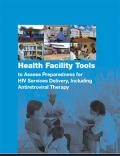
Resource | Tools,
To introduce HIV-related services in health and community facilities, it is essential that a rapid and comprehensive process of appraisal and implementation planning occur for each site. This process includes several steps to ensure that the proper contacts are made, accurate data are gathered and used for program planning, and comprehensive program planning occurs. Participants from technical and program support areas should be involved in all aspects of the process. This manual outlines the rapid appraisal and implementation planning framework used to plan service delivery in FHI-supported sites and provides tools to be used along the way.
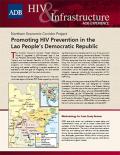
Resource | Publications,
The Northern Economic Corridor Project (National Route 3) upgraded a 220-kilometer road in the Lao People’s Democratic Republic (Lao PDR) linking Thailand and the People’s Republic of China (PRC). The project incorporated awareness and prevention education programs on human immunodeficiency virus (HIV), and drug and people trafficking in several aspects of its operations with the goal of mitigating risk and adverse outcomes associated with the road construction.
Route 3 passes through 94 villages and towns in the poor, northwest region of the Lao PDR. Road upgrading will bring significant economic development to two of the country’s poorest provinces (Louang Namtha and Bokeo).
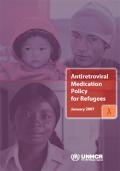
Resource | Publications,
The United Nations High Commissioner for Refugees’ (UNHCR) ARV policy for refugees is designed to offer guidance to UNHCR and its implementing and operational partners as well as to host Governments on the provision of the different forms of available ARVs, namely short-term preventive ARVs to avoid mother-to-child transmission (PMTCT) and post-exposure prophylaxis (PEP) to reduce the likelihood of HIV transmission in certain situations as well as long term ART. This document sets the objectives as to the availability of ARVs and ART for refugees and outlines the scope of engagement and the responsibilities of UNHCR offices in working towards the achievement of these objectives.
The document complements earlier UNHCR policy papers and guidelines related to HIV/AIDS and is consistent with international recommendations relating to ART. As with all HIV and AIDS policies and programmes,ARV interventions must be linked to prevention, care and support programmes.

Resource | Publications,
Delivered in a sermon on social justice four decades ago, Martin Luther King's words retain a powerful resonance. At the start of the 21st Century, we too are confronted with the “fierce urgency” of a crisis that links today and tomorrow. That crisis is climate change. It is still a preventable crisis—but only just. The world has less than a decade to change course. No issue merits more urgent attention—or more immediate action. Climate change is the defining human development issue of our generation. All development is ultimately about expanding human potential and enlarging human freedom. It is about people developing the capabilities that empower them to make choices and to lead lives that they value.
If the world acts now it will be possible—just possible—to keep 21st Century global temperature increases within a 2°C threshold above pre-industrial levels. Achieving this future will require a high level of leadership and unparalleled international cooperation.

Resource | Publications,
At the G8 meeting in Gleneagles in 2005 and again at the United Nations UNGASS session in 2006, world leaders promised to come as close as possible to providing universal access to AIDS treatment and prevention by 2010. Estimates of HIV incidence and prevalence will change, but by any account, today several million people in desperate need of AIDS treatment do not have access to it. And at the current pace of growth in treatment delivery, several million will not have access by the end of 2010. Broken promises will mean millions of deaths.
Scale up of AIDS treatment is driving unprecedented expansion of health delivery and, in the process, identifying critical challenges to health systems as well as practical solutions to address them. This report identifies many ways in which governments and global agencies must act to correct systems essential to delivery of health. In the area of antiretroviral drug access—a special focus of this report—our research found that in many countries drug registration, procurement, and supply management systems are inadequate, drug stock-outs are common, and most people are not being treated with ARV regimens that are consistent with recent WHO recommendations for improved first-line and standardized second-line treatment combinations.
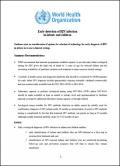
Resource | Tools,
The World Health Organization (WHO) recommends that national programmes establish capacity to provide early infant virological testing for HIV given the high risk of death by 2 years of age for infected infants and the increasing availability of paediatric antiretroviral treatment in many resource limited settings. Currently available assays and diagnostic platforms that should be considered by MOH programs for early infant HIV diagnosis include appropriately ongoing externally validated commercially and non-commercially available tests for HIV DNA (PCR) or HIV RNA.
This document is a guidance note on consideration of options for selection of technology for early diagnosis of HIV in infants in resource-limited settings.
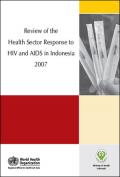
Resource | Publications,
The HIV epidemic in Indonesia is among the fastest growing in Asia although the aggregate HIV prevalence among adults (15-49 years of age) is still low (0.16%). An estimated 193,000 people were living with HIV as of 2006. The epidemic remains concentrated, in most parts of the country, among groups at high risk: populations sharing injecting equipment and engaging in unprotected sex.
The national commitment to respond effectively to the epidemic is strong. An impressive expansion of the response to the epidemic has been seen in the last two to three years but major disparities exist: geographical, the nature and size of the epidemic, health systems capacity, and available resources.
As part of the process of development of the National Strategic Plan on HIV/AIDS for 2007-2011, the Ministry of Health and the World Health Organization (WHO), in collaboration with a range of partners, organized, from 5 to 17 February 2007, a review of the health sector response to the HIV epidemic in Indonesia. The overall objective was to review progress in the national AIDS programme, especially in areas related to the health sector response, and recommend appropriate measures towards revision of interventions and strategies.
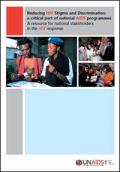
Resource | Publications,
Despite the pervasiveness of HIV-related stigma and discrimination in national HIV epidemics and their harmful impact in terms of public health and human rights, they remain seriously neglected issues in most national responses to HIV.
National AIDS programmes – together with key partners – can take concrete steps to address these
critical obstacles and help pave the way towards universal access to prevention, treatment, care and support. The UN system, funding mechanisms and bilateral partners can support countries – through advocacy, strategic planning, technical assistance, resource mobilisation and other means – to reduce stigma and discrimination related to HIV. These efforts will not only help countries reach key targets for universal access and Millennium Development Goal 6, they will also protect and promote human rights, foster respect for people living with HIV and other affected groups, and reduce the transmission of HIV.

Resource | Publications,
The International Center for Research on Women (ICRW) conducted research in South Asia on emerging efforts in women’s inheritance and property rights as an AIDS response. This special edition is for audiences of the International Congress on AIDS in Asia and the Pacific, which features a Regional Court of Women and symposium on the subject.
In addition to the research outlined in Women’s Property Rights as an AIDS Response, and with input from UNDP, this edition includes a supplementary discussion on the current state of HIV and AIDS in Asia Pacific and the potential pathways of secure property rights for women to mitigate HIV and AIDS.
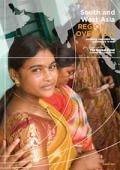
Resource | Publications,
The Global Fund to Fight AIDS, Tuberculosis and Malaria was formed in 2002 in response to the unacceptably high losses from the pandemics. It is a unique global public/private partnership dedicated to the massive scale-up of financing to prevent and treat these diseases in lower-income countries. This partnership between governments, civil society, the private sector and affected communities represents a new approach to international health financing. The Global Fund works in close collaboration with other organizations to supplement and support existing efforts dealing with the three diseases.
The Global Fund’s grant portfolio is organized into eight regions, which are managed by eight corresponding clusters in the Global Fund Secretariat. This overview provides a brief insight into the burden of HIV/AIDS, malaria and tuberculosis in each of these countries and offers a brief description of the Global Fund grants active there. The overview features a number of success stories from these states and shares the latest performance indicators for grants attributed to countries in the South and West Asia region.





